Ultra Sensitivity Silicon-Based Photonic Crystal Microcavity Biosensors for Plasma Protein Detection in Patients with Pancreatic Cancer
Abstract
1. Introduction
2. Materials and Methods
2.1. Device Principles
2.2. Device Characterization
2.3. Functionalization
2.4. Antibodies, Coupling Reagents and Derivatization
2.5. Pancreatic Cancer Plasma Samples
3. Results and Discussion
4. Conclusions
Author Contributions
Funding
Acknowledgments
Conflicts of Interest
References
- John, S. Strong localization of photons in certain disordered dielectric superlattices. Phys. Rev. Lett. 1987, 58, 2486. [Google Scholar] [CrossRef]
- Estevez, M.C.; Alvarez, M.; Lechuga, L.M. Integrated optical devices for lab-on-a-chip biosensing applications. Laser Photonics Rev. 2012, 6, 463–487. [Google Scholar] [CrossRef]
- Passaro, V.; Tullio, C.; Troia, B.; Notte, M.; Giannoccaro, G.; Leonardis, F. Recent advances in integrated photonic sensors. Sensors 2012, 12, 15558–15598. [Google Scholar] [CrossRef]
- Vollmer, F.; Yang, L. Review Label-free detection with high-Q microcavities: A review of biosensing mechanisms for integrated devices. Nanophotonics 2012, 1, 267–291. [Google Scholar] [CrossRef]
- Zhang, B.; Morales, A.W.; Peterson, R.; Tang, L.; Ye, J.Y. Label-free detection of cardiac troponin I with a photonic crystal biosensor. Biosens. Bioelectron. 2014, 58, 107–113. [Google Scholar] [CrossRef]
- Yanik, A.A.; Huang, M.; Artar, A.; Chang, T.Y.; Altug, H. Integrated nanoplasmonic-nanofluidic biosensors with targeted delivery of analytes. Appl. Phys. Lett. 2010, 96, 021101. [Google Scholar] [CrossRef]
- Anker, J.N.; Hall, W.P.; Lyandres, O.; Shah, N.C.; Zhao, J.; Van Duyne, R.P. Biosensing with plasmonic nanosensors. In Nanoscience and Technology: A Collection of Reviews from Nature Journals; World Scientific: Singapore, 2010; pp. 308–319. [Google Scholar]
- Iqbal, M.; Gleeson, M.A.; Spaugh, B.; Tybor, F.; Gunn, W.G.; Hochberg, M.; Baehr-Jones, T.; Bailey, R.C.; Gunn, L.C. Label-free biosensor arrays based on silicon ring resonators and high-speed optical scanning instrumentation. IEEE J. Sel. Top. Quantum Electron. 2010, 16, 654–661. [Google Scholar] [CrossRef]
- Chao, C.Y.; Guo, L.J. Biochemical sensors based on polymer microrings with sharp asymmetrical resonance. Appl. Phys. Lett. 2003, 83, 1527–1529. [Google Scholar] [CrossRef]
- McClellan, M.S.; Domier, L.L.; Bailey, R.C. Label-free virus detection using silicon photonic microring resonators. Biosens. Bioelectron. 2012, 31, 388–392. [Google Scholar] [CrossRef]
- Janz, S.; Xu, D.X.; Vachon, M.; Sabourin, N.; Cheben, P.; McIntosh, H.; Ding, H.; Wang, S.; Schmid, J.; Delâge, A.; et al. Photonic wire biosensor microarray chip and instrumentation with application to serotyping of Escherichia coliisolates. Opt. Express 2013, 21, 4623–4637. [Google Scholar] [CrossRef]
- Wei, X.; Mares, J.W.; Gao, Y.; Li, D.; Weiss, S.M. Biomolecule kinetics measurements in flow cell integrated porous silicon waveguides. Biomed. Opt. Express 2012, 3, 1993–2003. [Google Scholar] [CrossRef] [PubMed][Green Version]
- Qin, K.; Zhao, Y.; Hu, S.; Weiss, S.M. Enhancing the sensitivity of slow light MZI biosensors through multi-hole defects. In Proceedings of the Frontiers in Biological Detection: From Nanosensors to Systems X, San Francisco, CA, USA, 27 January–1 February 2018; Volume 10510, p. 1051002. [Google Scholar]
- Liu, Q.; Tu, X.; Kim, K.W.; Kee, J.S.; Shin, Y.; Han, K.; Yoon, Y.J.; Lo, G.Q.; Park, M.K. Highly sensitive Mach–Zehnder interferometer biosensor based on silicon nitride slot waveguide. Sens. Actuators B Chem. 2013, 188, 681–688. [Google Scholar] [CrossRef]
- Hu, S.; Zhao, Y.; Qin, K.; Retterer, S.T.; Kravchenko, I.I.; Weiss, S.M. Enhancing the sensitivity of label-free silicon photonic biosensors through increased probe molecule density. ACS Photonics 2014, 1, 590–597. [Google Scholar] [CrossRef]
- Chakravarty, S.; Lai, W.C.; Zou, Y.; Drabkin, H.A.; Gemmill, R.M.; Simon, G.R.; Chin, S.H.; Chen, R.T. Multiplexed specific label-free detection of NCI-H358 lung cancer cell line lysates with silicon based photonic crystal microcavity biosensors. Biosens. Bioelectron. 2013, 43, 50–55. [Google Scholar] [CrossRef]
- Kang, C.; Phare, C.T.; Vlasov, Y.A.; Assefa, S.; Weiss, S.M. Photonic crystal slab sensor with enhanced surface area. Opt. Express 2010, 18, 27930–27937. [Google Scholar] [CrossRef]
- Lončar, M.; Scherer, A.; Qiu, Y. Photonic crystal laser sources for chemical detection. Appl. Phys. Lett. 2003, 82, 4648–4650. [Google Scholar] [CrossRef]
- Lai, W.C.; Chakravarty, S.; Zou, Y.; Chen, R.T. Silicon nano-membrane based photonic crystal microcavities for high sensitivity bio-sensing. Opt. Lett. 2012, 37, 1208–1210. [Google Scholar] [CrossRef]
- Chakravarty, S.; Chen, X.; Tang, N.; Lai, W.C.; Zou, Y.; Yan, H.; Chen, R.T. Review of design principles of 2D photonic crystal microcavity biosensors in silicon and their applications. Front. Optoelectron. 2016, 9, 206–224. [Google Scholar] [CrossRef]
- Zou, Y.; Chakravarty, S.; Zhu, L.; Chen, R.T. The role of group index engineering in series-connected photonic crystal microcavities for high density sensor microarrays. Appl. Phys. Lett. 2014, 104, 141103. [Google Scholar] [CrossRef]
- Yang, C.J.; Chakravarty, S.; Yan, H.; Wang, Z.; Chen, R.T. Wide dynamic range sensing in photonic crystal microcavity biosensors. In CLEO: Science and Innovations; Optical Society of America: Washington, DC, USA, 2014; p. STh4H–5. [Google Scholar]
- Yan, H.; Yang, C.J.; Zou, Y.; Tang, N.; Chakravarty, S.; Chen, R.T. Wide dynamic range specific detection of therapeutic drugs by photonic crystal microcavity arrays. In Proceedings of the 2015 Conference on Lasers and Electro-Optics (CLEO), San Jose, CA, USA, 10–15 May 2015; pp. 1–2. [Google Scholar]
- Yan, H.; Yang, C.J.; Wang, Z.; Tang, N.; Chakravarty, S.; Chen, R.T. Photonic crystal (PC) waveguide based optical filters for dense integration of high sensitivity PC biosensors. In CLEO: Applications and Technology; Optical Society of America: Washington, DC, USA, 2014; p. JTu4A–94. [Google Scholar]
- Zou, Y.; Chakravarty, S.; Kwong, D.N.; Lai, W.C.; Xu, X.; Lin, X.; Hosseini, A.; Chen, R.T. Cavity-waveguide coupling engineered high sensitivity silicon photonic crystal microcavity biosensors with high yield. IEEE J. Sel. Top. Quantum Electron. 2014, 20, 171–180. [Google Scholar] [CrossRef]
- Yang, C.J.; Tang, N.; Yan, H.; Chakravarty, S.; Li, D.; Chen, R.T. 193nm lithography fabricated high sensitivity photonic crystal microcavity biosensors for plasma protein detection in patients with pancreatic cancer. In CLEO: Science and Innovations; Optical Society of America: Washington, DC, USA, 2015; p. STu4K–5. [Google Scholar]
- Fong, Z.V.; Winter, J.M. Biomarkers in pancreatic cancer: Diagnostic, prognostic, and predictive. Cancer J. 2012, 18, 530–538. [Google Scholar] [CrossRef] [PubMed]
- Chakravarty, S.; Hosseini, A.; Xu, X.; Zhu, L.; Zou, Y.; Chen, R.T. Analysis of ultra-high sensitivity configuration in chip-integrated photonic crystal microcavity bio-sensors. Appl. Phys. Lett. 2014, 104, 191109. [Google Scholar] [CrossRef]
- Lai, W.C.; Chakravarty, S.; Zou, Y.; Guo, Y.; Chen, R.T. Slow light enhanced sensitivity of resonance modes in photonic crystal biosensors. Appl. Phys. Lett. 2013, 102, 041111. [Google Scholar] [CrossRef] [PubMed]
- Mortensen, N.A.; Xiao, S.; Pedersen, J. Liquid-infiltrated photonic crystals: enhanced light-matter interactions for lab-on-a-chip applications. Microfluid. Nanofluidics 2008, 4, 117–127. [Google Scholar] [CrossRef]
- Kim, J. Effects of Curing Conditions on the Structure and Stability of Amino-Functionalized Organic Films on Silicon Substrates; PIKE Technologies: Fitchburg, WI, USA, 2010. [Google Scholar]
- Yi, M.; Jeong, K.H.; Lee, L.P. Theoretical and experimental study towards a nanogap dielectric biosensor. Biosens. Bioelectron. 2005, 20, 1320–1326. [Google Scholar] [CrossRef] [PubMed]
- Lorentz-Lorenz Equation. Available online: https://www.oxfordreference.com/view/10.1093/oi/authority.20110803100115114 (accessed on 9 March 2020).

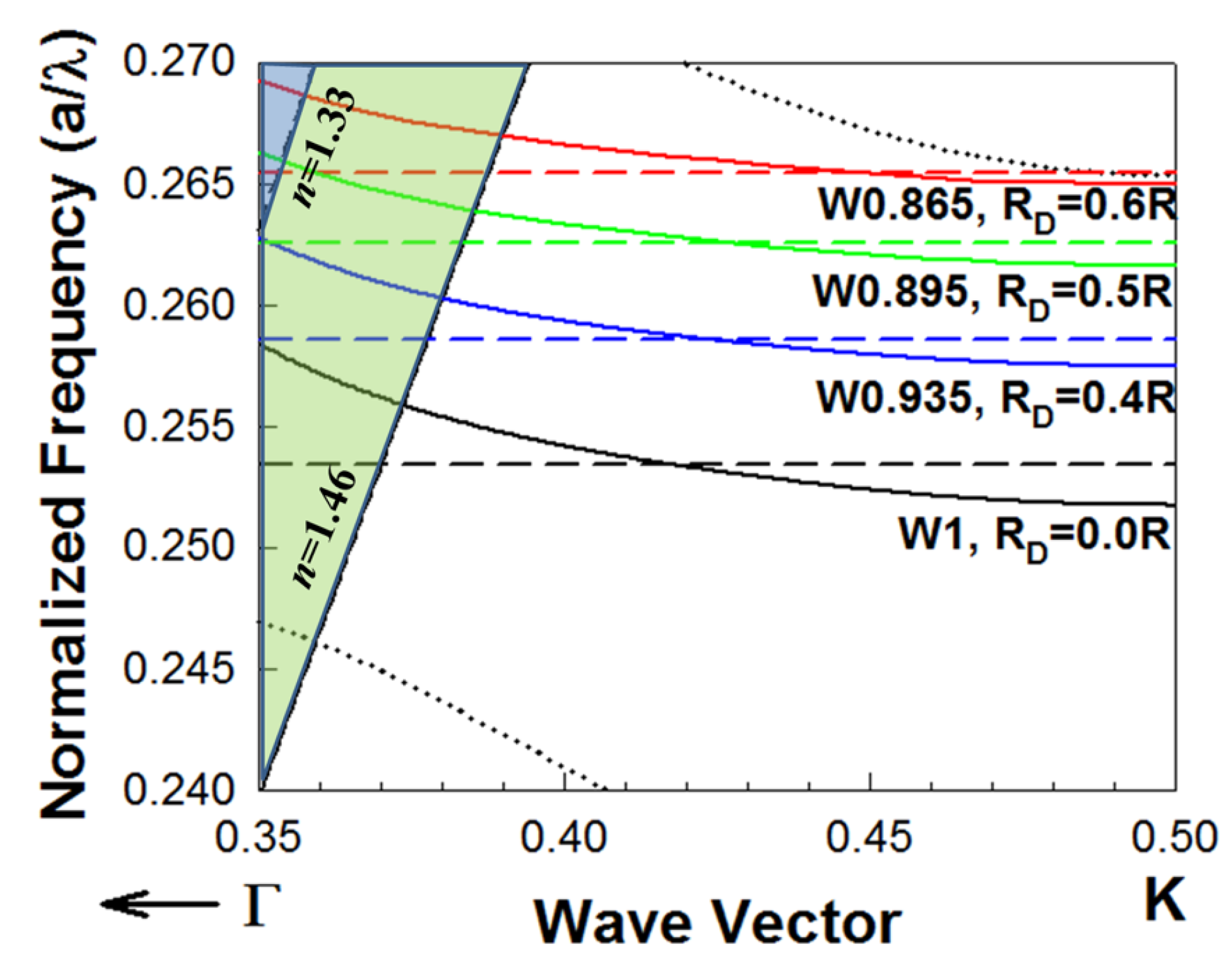
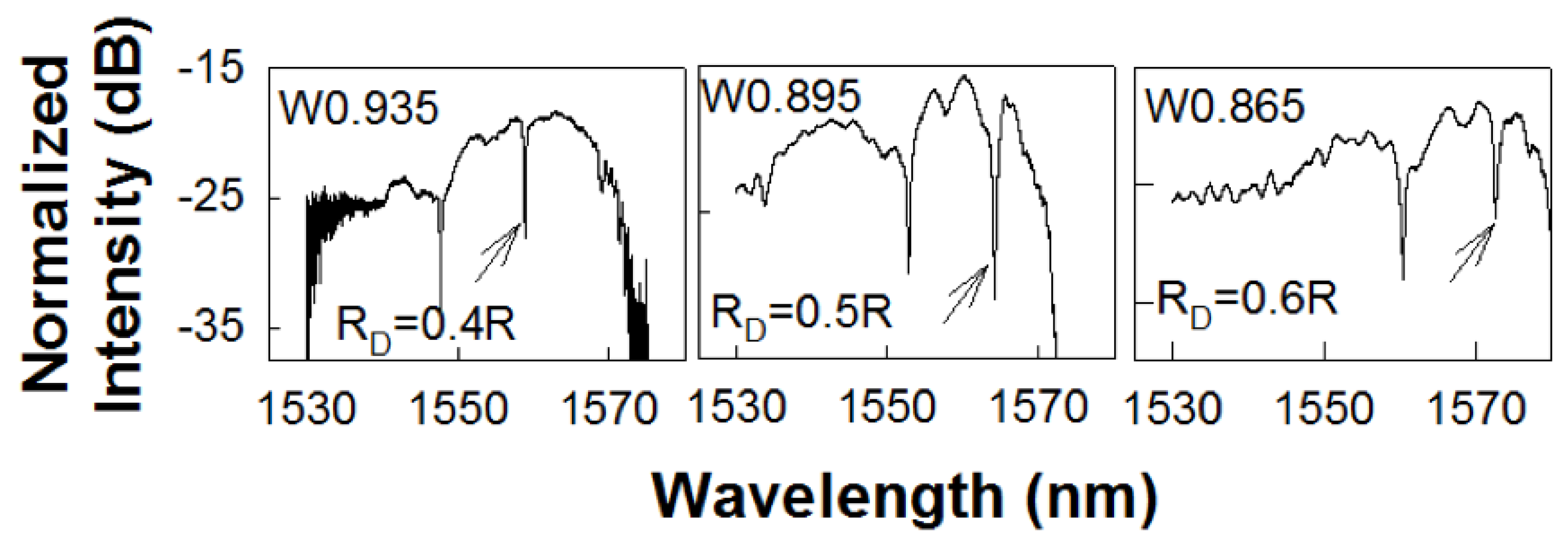

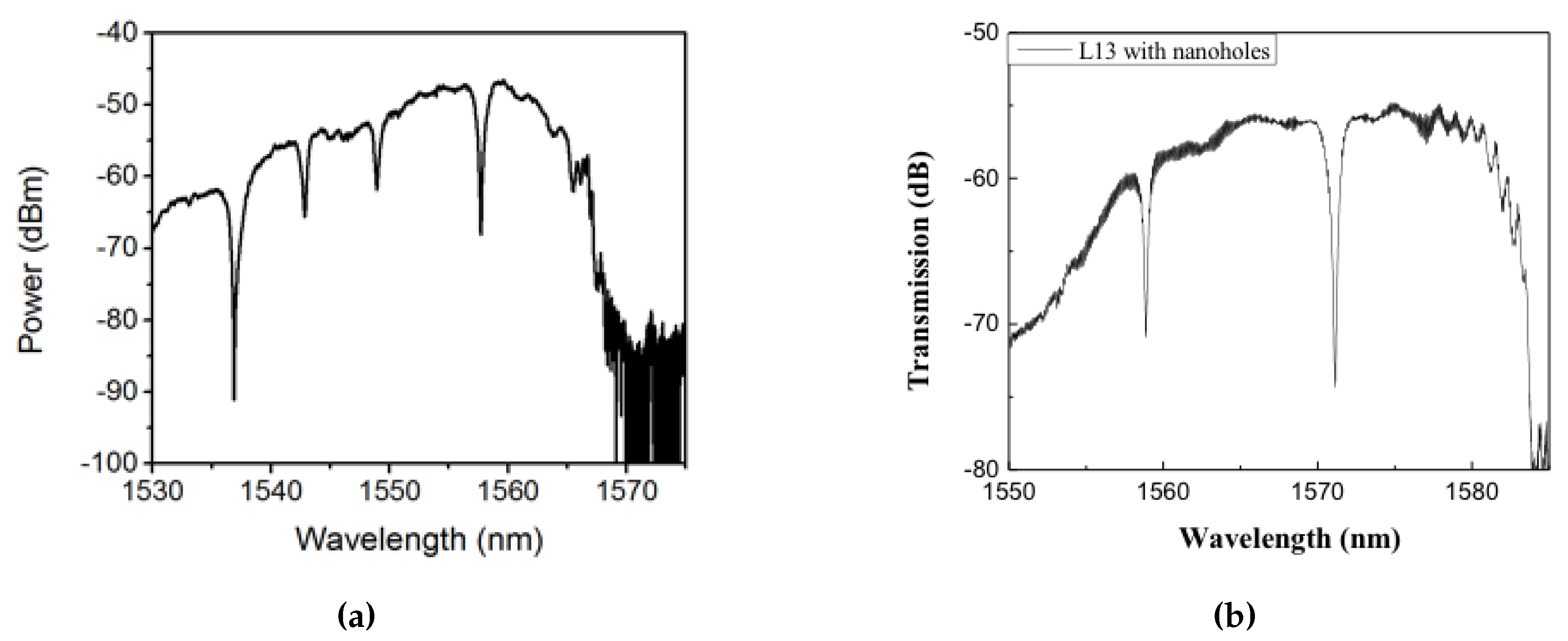
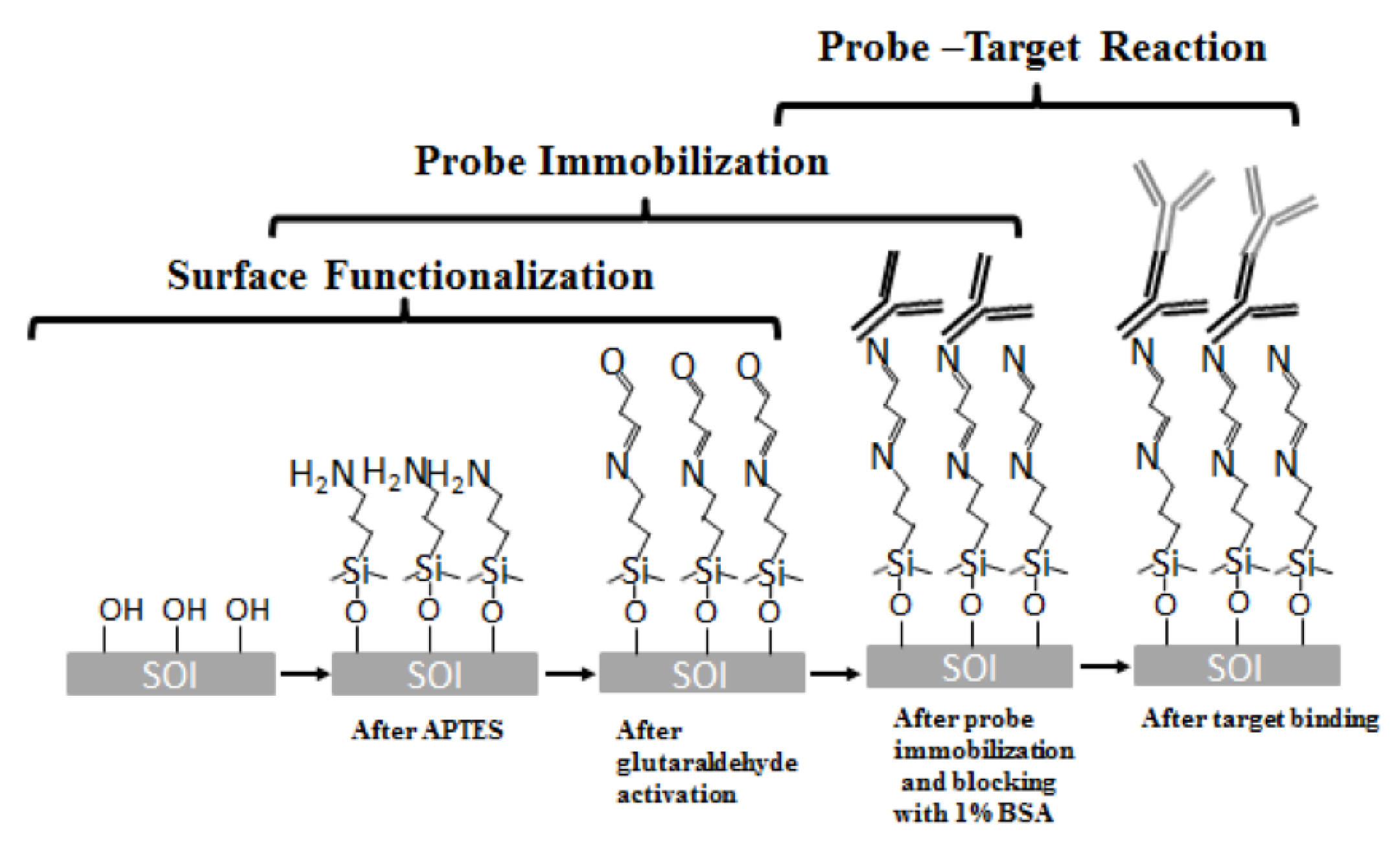

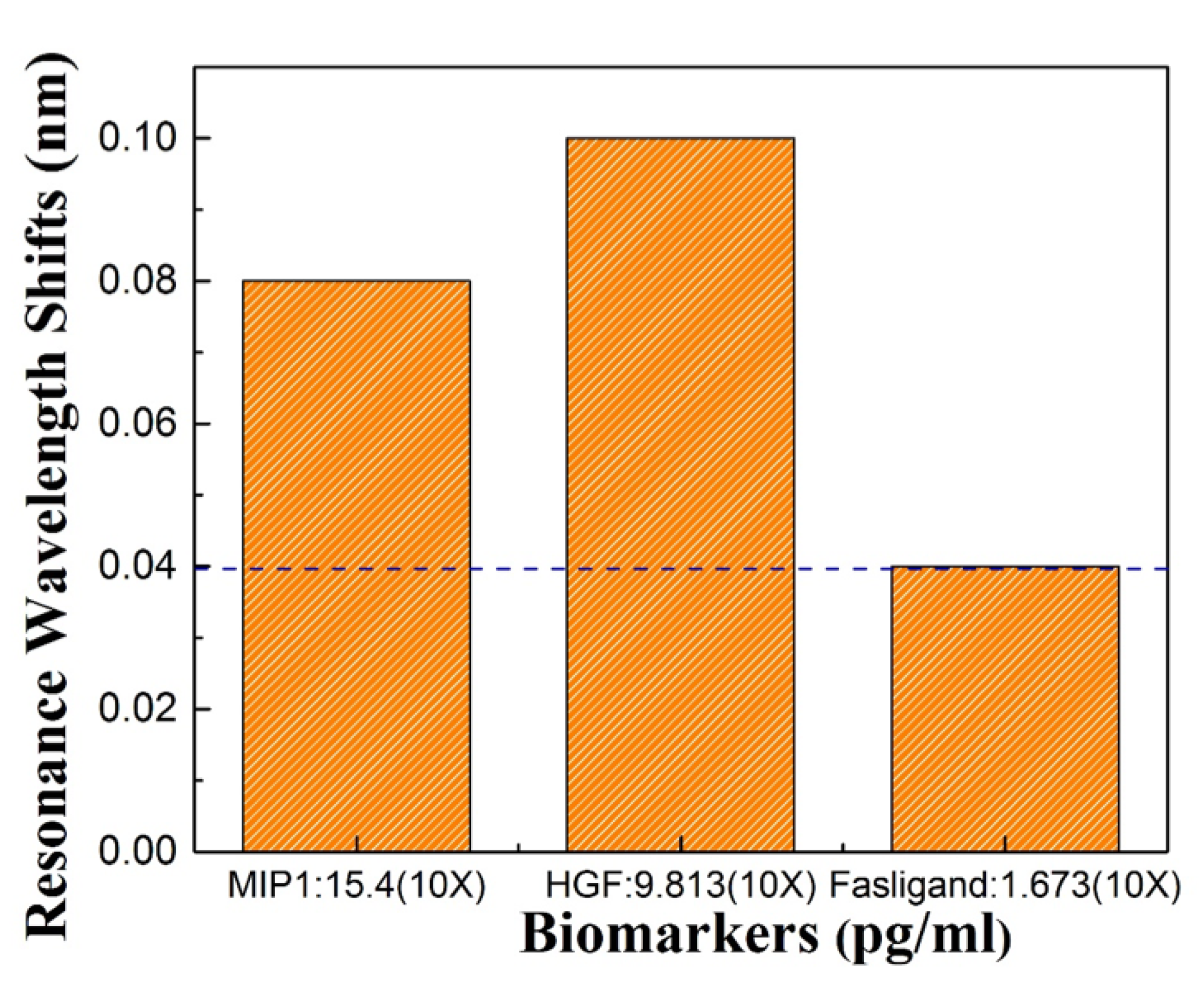
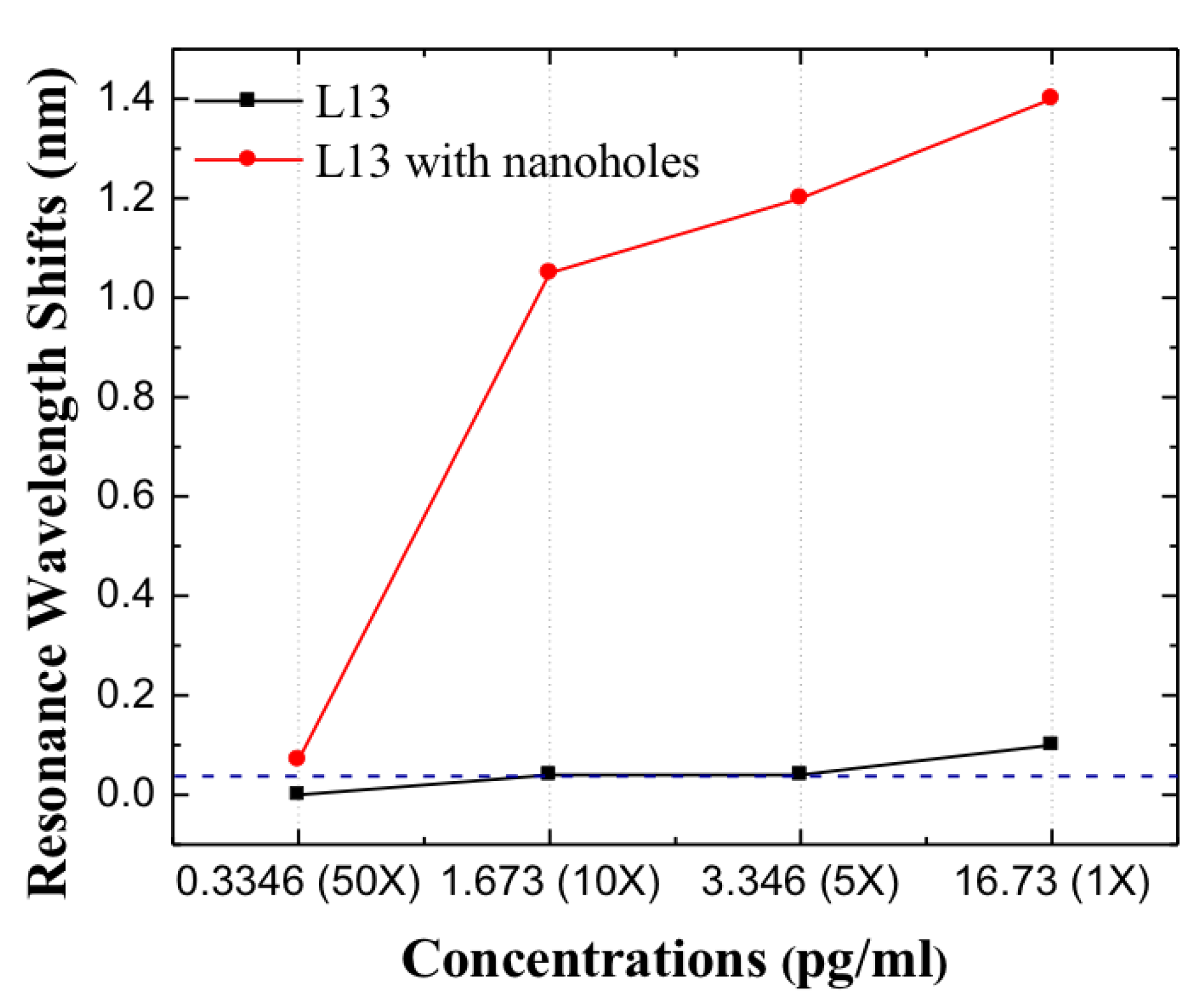
| Items | Company | Cat# |
|---|---|---|
| 3-aminopropyl-triethoxy-silane (3-APTES) | Acros | 919-30-2 |
| Fasligand/CD178 Antibody (Fasligand) | Thermo Scientific | A5-32400 |
| MacrophageInflammatory ProteinsAntibody (MIP1) | Thermo Scientific | 710391 |
| Hepatocyte Growth FactorAntibody (HGF) | Thermo Scientific | 701283 |
| Human Immunoglobulin G Antibody (Human IgG) | Abcam | Ab109489 |
| Antigen | Antibody | |||||
|---|---|---|---|---|---|---|
| HGF | MIP1 | Fasligand | HGF | MIP1 | Fasligand | |
| Molecular Weight (kD) | 80 | 8 | 38 | 64 | 11 | 68 |
| Biomarker | Our Detection Concentration (pg/mL) | ELISA Detection Concentration (pg/mL) |
|---|---|---|
| Macrophage Inflammatory Proteins Antibody (MIP1) | 15.44 (L13) | 3.9 |
| Fasligand/CD178 Antibody (Fasligand) | 0.334 (L13 with nanoholes) | 6.44 |
| Hepatocyte Growth Factor Antibody (HGF) | 9.813 (L13) | 47.72 |
| Human Immunoglobulin G Antibody (Human IgG) | No reaction with our probe | Not applicable |
© 2020 by the authors. Licensee MDPI, Basel, Switzerland. This article is an open access article distributed under the terms and conditions of the Creative Commons Attribution (CC BY) license (http://creativecommons.org/licenses/by/4.0/).
Share and Cite
Yang, C.-J.; Yan, H.; Tang, N.; Zou, Y.; Al-Hadeethi, Y.; Xu, X.; Dalir, H.; Chen, R.T. Ultra Sensitivity Silicon-Based Photonic Crystal Microcavity Biosensors for Plasma Protein Detection in Patients with Pancreatic Cancer. Micromachines 2020, 11, 282. https://doi.org/10.3390/mi11030282
Yang C-J, Yan H, Tang N, Zou Y, Al-Hadeethi Y, Xu X, Dalir H, Chen RT. Ultra Sensitivity Silicon-Based Photonic Crystal Microcavity Biosensors for Plasma Protein Detection in Patients with Pancreatic Cancer. Micromachines. 2020; 11(3):282. https://doi.org/10.3390/mi11030282
Chicago/Turabian StyleYang, Chun-Ju, Hai Yan, Naimei Tang, Yi Zou, Yas Al-Hadeethi, Xiaochuan Xu, Hamed Dalir, and Ray T. Chen. 2020. "Ultra Sensitivity Silicon-Based Photonic Crystal Microcavity Biosensors for Plasma Protein Detection in Patients with Pancreatic Cancer" Micromachines 11, no. 3: 282. https://doi.org/10.3390/mi11030282
APA StyleYang, C.-J., Yan, H., Tang, N., Zou, Y., Al-Hadeethi, Y., Xu, X., Dalir, H., & Chen, R. T. (2020). Ultra Sensitivity Silicon-Based Photonic Crystal Microcavity Biosensors for Plasma Protein Detection in Patients with Pancreatic Cancer. Micromachines, 11(3), 282. https://doi.org/10.3390/mi11030282





